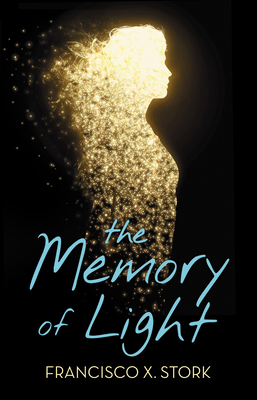
Just finished The Memory of Light by Francisco X. Stork. The exploration of depression is honest and may give words as well as hope to those within the condition. Learning to exist in the midst of the trial is displayed with a tender compassion.
Watch for Vicky's story of crisis and recovery. It may help you find your own memory of light or assist another along the path beside you.
The Memory of Light
by Francisco X. Stork
Arthur A. Levine Books, Scholastic, 2016
Edited by Cheryl Klein
Viewing: Blog Posts Tagged with: Arthur A. Levine, Most Recent at Top [Help]
Results 1 - 25 of 27
Blog: readergirlz (Login to Add to MyJacketFlap)
JacketFlap tags: Lorie Ann Grover, Scholastic, Cheryl Klein, francisco x. stork, Arthur A. Levine, Memory of Light, Add a tag
Blog: Galley Cat (Mediabistro) (Login to Add to MyJacketFlap)
JacketFlap tags: Publishing, Arthur A. Levine, Katie Kath, Authors, Add a tag
The cover has been revealed for Arthur A. Levine’s forthcoming picture book, What a Beautiful Morning. We’ve embedded the full image for the jacket design above—what do you think?
According to School Library Journal, Katie Kath served as the illustrator for this project. Running Press Kids has scheduled the publication date for August 9.
Add a CommentBlog: A Fuse #8 Production (Login to Add to MyJacketFlap)
JacketFlap tags: Uncategorized, Arthur A. Levine, cover reveal, Add a tag
It’s a cloudy February here in Illinois. Yesterday the heavens opened up and let loose a downpour. Today it is wet if not actively raining. We are in the thick of winter, albeit an oddly warm one. With all this in mind, I think we need some cheering up.
Now a friend recently pointed out to me that there are a plethora of books coming out this year penned by publishers and agents. Crazy, right? If I’d been paying attention I’d have put that in my SLJ trending piece. In any case, today’s cover reveal is from the man who had the wherewithal to bring us Harry Potter. Arthur A. Levine has a new picture book out (and it’s hardly his first) and it’s coming to our shelves on August 9th.
Behold!
Aw. Bring it all home, Katie Kath.
Thanks to Cassie Drumm for the pic.
Blog: readergirlz (Login to Add to MyJacketFlap)
JacketFlap tags: Lorie Ann Grover, Scholastic, Markus Zusak, Arthur A. Levine, Under Dogs, Did You Read, Add a tag

How wonderful to have three books in one collection: The Underdog, Fighting Ruben Wolfe, and Getting the Girl, by Markus Zusak. Thanks much, Scholastic! (And Arthur A. Levine for bringing the set together in hardback originally!) These books were written prior to The Book Thief and stand strongly. In my mind I've sequestered Markus' beautiful, poetic language to The Book Thief, thinking it fit the tone of that lifework so well. However, reading of the Wolfe brothers, I'm reminded it is Markus' voice which blooms with metaphors across his entire body of work. For me, it creates a sympathy, an understanding, a care for Cameron, the youngest brother making his way through his Australian adolescence.
From crazy schemes, to searches for identity, to family and friend relationships, Ruben and Cameron's exploits entertain and touch the heart with resonating honesty and truth. This is one to look for rgz, if you missed it go by. You have to get to know these brothers. Raise the boyfriend bar.
Under Dogs
By Markus Zusak
Scholastic, paperback, 2013
Blog: A Fuse #8 Production (Login to Add to MyJacketFlap)
JacketFlap tags: Reviews, nonfiction picture books, Scholastic, Best Books, Arthur A. Levine, Sean Qualls, Selina Alko, Best Books of 2015, Reviews 2015, 2015 reviews, 2015 nonfiction picture books, Add a tag
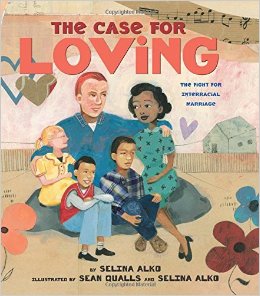 The Case for Loving: The Fight for Interracial Marriage
The Case for Loving: The Fight for Interracial Marriage
By Selina Alko
Illustrated by Sean Qualls
Arthur A. Levine Books (an imprint of Scholastic)
$18.99
ISBN: 978-0545478533
Ages 4-7
On shelves now.
When the Supreme Court ruled on June 26, 2015 that same-sex couples could marry in all fifty states, I found myself, like many parents of young children, in the position of trying to explain the ramifications to my offspring. Newly turned four, my daughter needed a bit of context. After all, as far as she was concerned gay people had always had the right to marry so what exactly was the big deal here? In times of change, my back up tends to be children’s books that discuss similar, but not identical, situations. And what book do I own that covers a court case involving the legality of people marrying? Why, none other than The Case for Loving: The Fight for Interracial Marriage by creative couple Selina Alko and Sean Qualls. It’s almost too perfect that the book has come out the same year as this momentous court decision. Discussing the legal process, as well as the prejudices of the time, the book offers to parents like myself not just a window to the past, but a way of discussing present and future court cases that involve the personal lives of everyday people. Really, when you take all that into consideration, the fact that the book is also an amazing testament to the power of love itself . . . well, that’s just the icing on the cake.
In 1958 Richard Loving, a white man, fell in love with Mildred Jeter, a black/Native American woman. Residents of Virginia, they could not marry in their home state so they did so in Washington D.C. instead. Then they turned right around and went home to Virginia. Not long after they were interrupted in the night by a police invasion. They were charged with “unlawful cohabitation” and were told in no uncertain terms that if they were going to continue living together then they needed to leave Virginia. They did, but they also hired lawyers to plead their case. By 1967 the Lovings made it all the way to The Supreme Court where their lawyers read a prepared statement from Richard. It said, “Tell the court I love my wife, and it is just unfair that I can’t live with her in Virginia.” In a unanimous ruling, the laws restricting such marriages were struck down. The couple returned to Virginia, found a new house, and lived “happily (and legally) ever after.” An Author’s Note about her marriage to Sean Qualls (she is white and he is black) as well as a note about the art, Sources, and Suggestions for Further Reading appear at the end of the book.
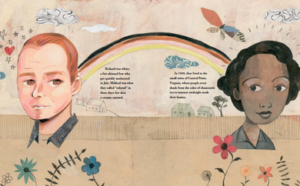 “How do you sue someone?” Here’s a challenge. Explain the concept of suing the government to a four-year-old brain. To do so, you may have to explain a lot of connected concepts along the way. What is a lawyer? And a court? And, for that matter, why are the laws (and cops) sometimes wrong? So when I pick up a book like The Case for Loving as a parent, I’m desperately hoping on some level that the authors have figured out how to break down these complex questions into something small children can understand and possibly even accept. In the case of this book, the legal process is explained as simply as possible. “They wanted to return to Virginia for good, so they hired lawyers to help fight for what was right.” And then later, “It was time to take the Loving case all the way to The Supreme Court.” Now the book doesn’t explain what The Supreme Court was necessarily, and that’s where the art comes in. Much of the heavy lifting is done by the illustrations, which show the judges sitting in a row, allowing parents like myself the chance to explain their role. Here you will not find a deep explanation of the legal process, but at least it shows a process and allows you to fill in the gaps for the young and curious.
“How do you sue someone?” Here’s a challenge. Explain the concept of suing the government to a four-year-old brain. To do so, you may have to explain a lot of connected concepts along the way. What is a lawyer? And a court? And, for that matter, why are the laws (and cops) sometimes wrong? So when I pick up a book like The Case for Loving as a parent, I’m desperately hoping on some level that the authors have figured out how to break down these complex questions into something small children can understand and possibly even accept. In the case of this book, the legal process is explained as simply as possible. “They wanted to return to Virginia for good, so they hired lawyers to help fight for what was right.” And then later, “It was time to take the Loving case all the way to The Supreme Court.” Now the book doesn’t explain what The Supreme Court was necessarily, and that’s where the art comes in. Much of the heavy lifting is done by the illustrations, which show the judges sitting in a row, allowing parents like myself the chance to explain their role. Here you will not find a deep explanation of the legal process, but at least it shows a process and allows you to fill in the gaps for the young and curious.
It was very interesting to me to see how Alko and Qualls handled the art in this book. I’ve often noticed that editors like to choose Sean as an artist when they want an illustrator that can offset some of the darker aspects of a work. For example, take Margarita Engle’s magnificently sordid Pura Belpre Medal winner The Poet Slave of Cuba. A tale of torture, gore, and hope, Qualls’ art managed to represent the darkness with a lighter touch, while never taking away from the important story at hand. In The Case for Loving he has scaled the story down a bit and given it a simpler edge. His characters are a bit broader and more cartoonlike than those in, say, Dizzy. This is due in part to Alko’s contributions. As they say in their “About the Art” section at the back of the book, Alko’s art is all about bold colors and Sean’s is about subtle layers of color and texture. Together, they alleviate the tension in different scenes. Moments that could be particularly frightening, as when the police burst into the Lovings’ bedroom to arrest them, are cast instead as simply dramatic. I noticed too that characters were much smaller in this book than they tend to be in Sean’s others. It was interesting to note the moments when that illustrators made the faces of Richard and Virginia large. The page early in the book where Richard and Mildred look at one another over the book’s gutter pairs well with the page later in the book where their faces appear on posters behind bars against the words “Unlawful Cohabitation”. But aside from those two double spreads the family is small, often seen just outside their different respective homes. It seemed to be important to Qualls and Alko to show them as a family unit as often as possible.
 Few books are perfect, and Loving has its off-kilter moments from time to time. For example, it describes darker skin tones in terms of food. That’s not a crime, of course, but you rarely hear white skin described as “white as aged cheese” or “the color of creamy mayonnaise” so why is dark colored skin always edible? In this book Mildred is “a creamy caramel” and she lives where people ranged from “the color of chamomile tea” to darker shades. A side issue has arisen concerning Mildred’s identification as Native American and whether or not the original case made more of her African-American roots because it would build a stronger case in court. This is a far bigger issue than a picture book could hope to encompass, though I would be interested in a middle grade or young adult nonfiction book on the topic that went into the subject in a little more depth.
Few books are perfect, and Loving has its off-kilter moments from time to time. For example, it describes darker skin tones in terms of food. That’s not a crime, of course, but you rarely hear white skin described as “white as aged cheese” or “the color of creamy mayonnaise” so why is dark colored skin always edible? In this book Mildred is “a creamy caramel” and she lives where people ranged from “the color of chamomile tea” to darker shades. A side issue has arisen concerning Mildred’s identification as Native American and whether or not the original case made more of her African-American roots because it would build a stronger case in court. This is a far bigger issue than a picture book could hope to encompass, though I would be interested in a middle grade or young adult nonfiction book on the topic that went into the subject in a little more depth.
Recently I read my kid another nonfiction picture book chronicling injustice called Drum Dream Girl by the aforementioned Margarita Engle. In that book a young girl isn’t allowed to drum because of her gender. My daughter was absolutely flabbergasted by the notion. When I read her The Case for Loving she was similarly baffled. And when, someday, someone writes a book about the landmark decision made by The Supreme Court to allow gay couples to wed, so too will some future child be just as floored by what seems completely normal to them. Until then, this is certainly a book written and published at just the right time. Informative and heartfelt all at once, it works beyond the immediate need. Context is not an easy thing to come by when we discuss complex subjects with our kids. It takes a book like this to give us the words we so desperately need. Many thanks then for that.
On shelves now.
Source: Galley sent from publisher for review.
Like This? Then Try:
- Separate is Never Equal by Duncan Tonatiuh
- The Girl From the Tar Paper School by Teri Kanefield
- Sit-In: How Four Friends Stood Up by Sitting Down by Andrea Davis Pinkney
Misc: Don’t forget to check out this incident that occurred involving this book and W. Kamau Bell’s treatment at Berkeley’s Elmwood Café.
Blog: Galley Cat (Mediabistro) (Login to Add to MyJacketFlap)
JacketFlap tags: Kathleen Anderson, Authors, Publishing, Arthur A. Levine, Emma Donoghue, Add a tag
 Emma Donoghue has signed a deal with Scholastic to write her debut middle grade book. As a writer, Donoghue (pictured, via) has become well-known for her popular adult novel Room.
Emma Donoghue has signed a deal with Scholastic to write her debut middle grade book. As a writer, Donoghue (pictured, via) has become well-known for her popular adult novel Room.
The team at the Arthur A. Levine Books imprint has scheduled the release of The Lotterys Plus One for February 2017. Levine, the editor for this manuscript, negotiated the deal with Kathleen Anderson of the Anderson Literary Agency.
Here’s more from the press release: “The Lotterys Plus One introduces Sumac Lottery, a girl with six siblings, two moms, two dads, and a tranquil cloud-painted room in the big Victorian house they all call Camelottery. When her racist, homophobic grandfather nearly burns his house down, he has to move in with the Lotterys, a volatile situation about which no one is happy, least of all Sumac, who has to give up her room. The Lotterys Plus One is a funny, sensitive exploration of family, the limits of tolerance, and the possibilities of love.”
Add a CommentBlog: readergirlz (Login to Add to MyJacketFlap)
JacketFlap tags: Lorie Ann Grover, martha brockenbrough, Arthur A. Levine, Watch for It, The Game of Love and Death, Add a tag
readergirlz! This is our own Diva Martha Brockenbrough's next EPIC work. The stars are zooming in from the critics for this masterpiece. Rights are selling around the world. We are cheering and can't wait for you to read THE GAME OF LOVE AND DEATH!
Here's the overview for you:
Not since THE BOOK THIEF has the character of Death played such an original and affecting part in a book for young people.
Blog: The Official SCBWI 10th Annual New York Conference Blog (Login to Add to MyJacketFlap)
JacketFlap tags: Jennifer Laughran, Tina Wexler, LGBTQ, Lee Wind, Laurent Linn, Arthur A. Levine, Emma Dryden, #NY15SCBWI, Jane Yolen, Add a tag
With conference faculty guest agent Tina Wexler, agent Jennifer Laughran, Art Director and Author Laurent Linn, Best-Selling and Award-Winning Author Jane Yolen, editor Emma Dryden and editor and publisher Arthur A. Levine, our group of more than forty attendees gathered to share and talk about writing and illustrating LGBTQ characters and themes in works for children and teens.
In moments ranging from hilarious to somber, topics covered included picture book art notes (dos and don'ts), gender non-conformity, gender challenges in the English language, and the urgent need for more books with LGBTQ diversity.
At one point, an ally voiced a concern about writing from a queer perspective, and the consensus was to not hold back about writing from other points of view (outside your own.) To do your homework, to run it by people who are members of that community...
Arthur: "I urge you to not be self-conscious"
Jane: "In terms of getting it right. In terms of getting the feelings right."
It was a great conversation and the room was filled with a sense of warmth and community. We sat in a circle, each person sharing their name and what they're working on, with our conference faculty (and myself) chiming in with thoughts, advice and insights.
Once the session ended, many participants stayed to exchange contact information and mingle. The pictures are from that part of the evening:
I was honored to host - my thanks and appreciation to the panel and all the attendees!
Lee
Blog: The Official SCBWI 10th Annual New York Conference Blog (Login to Add to MyJacketFlap)
JacketFlap tags: Arthur A. Levine, #NY15SCBWI, Emily Clement, literary fiction, Scholastic, Add a tag
Emily Clement is an associate editor at Arthur A. Levine Books, an imprint of Scholastic. She has worked on books by Shaun Tan, Jaclyn Moriarty, Alaya Dawn Johnson, and Erin Bow, among others.
She manages her imprint’s international literature program, and has edited books translated from German, Dutch, and Russian. Emily attended Stanford University, followed by the Columbia Publishing Course, and translates children’s books from Italian. She grew up in Tempe, Arizona, and now lives in Brooklyn.
She talked to us about what that tricky word "literary" means, and how we can achieve it in our writing. But first, she told us the backstory behind a Russian novel coming out on the Arthur A. Levine spring list.
 Called "Playing A Part," it was published just after Russie passed anti-gay propaganda laws. While it wasn't illegal for the book to be published, it could not be shelved with children's books.
Called "Playing A Part," it was published just after Russie passed anti-gay propaganda laws. While it wasn't illegal for the book to be published, it could not be shelved with children's books.After she read about it in The Atlantic, she looked into acquiring it, not knowing whether it was well written or appropriate for their list. She discovered a "gorgeous, beautiful, moving, and sensitive novel." And now it's the first young adult novel to be translated from Russian into English.
"It's crazy that hasn't happened before," she said.
The word "literary" is a tricky one for her. She doesn't love talking about books as literary or commercial because the two things aren't mutually exclusive. And some people are put off by the concept of literary, so she always tries to pair the word "accessible with it."
Here are four items from her list of seven essential literary qualities:
- It's about something. The book tackles a big idea and one of the larger themes of life, challenging the reader to think from a new angle.
- It has voice. Voice is informed by the character and his or her world, and makes your work engaging and feel authentic.
- It has plot. You can tell if your plot is lacking if you can't explain your book's premise in a few sentences (and the usual cause is that your voice is getting in the way).
- It has resonant details. "Every piece of clothing, every meal, every book your characters read" is intentional.
Blog: The Official SCBWI 10th Annual New York Conference Blog (Login to Add to MyJacketFlap)
JacketFlap tags: editor, craft, Arthur A. Levine, Deborah Underwood, Add a tag
 |
| Arthur Levine and Deborah Underwood started off with a song. |
He founded his own imprint at Scholastic, Arthur A. Levine Books, in 1997. The imprint publishes everything from picture books through young adult novels. His authors and illustrators include Shaun Tan, Dan Santat, Markus Zusak, Francisco Stork, Erin Bow, Mike Jung, and Jaclyn Moriarty.
What's more, Arthur is the author of several picture books—A VERY BEARY TOOTH FAIRY, illustrated by Sarah Brannen, is the latest. So he knows about communicating from both sides of the email server.
He talked to us about things that can derail communication between editors and authors, using principles that work in critique groups (and in real life).
Here are three of the thoughtful, helpful tips he shared.
1. Don't leave anything out. The person you're writing to doesn't necessarily already agree with what you're trying to say. For example, if you describe something as a "circular story shape," does everyone know what you mean?
"The narrative was hurt by Jordan's snide remarks" might not be the best feedback, for example. The writer might not feel the remarks were snide. The writer might feel attacked.
A better way to say that might be to give a specific example, perhaps like this: When Jordan says his mother's kindergarten class is full of party poopers, he was less sympathetic. Did you intend for that to be the case?
The shorthand might feel insulting. The more specific reaction, built off positive reactions, is more clear and ultimately more helpful.
2. Leave some things out. He shared an exchange from a cover discussion where an author tactfully expressed preference for an earlier sketch, where an agent chimed in with something that sounded harsh and critical.
Don't assume everyone agrees with you. Inflammatory political commentary on Facebook can be off-putting, for example.
3. Be respectful of people's boundaries. A fellow editor told him the story of someone showing up with a manuscript at her home office. (Yikes!)
If you sense someone getting defensive or upset, back off, or apologize, or find a different way of communicating. When someone gets upset, it's natural to want to respond with equal anger. But the anger is a someone setting a boundary. Instead of charging the boundary, try retreating and apologizing, he said.
He talked also a bit about email, which gets a bad rap as a communication medium, but isn't always bad. Calling people when you're angry is a bad idea. Taking the time to think and compose a thoughtful email can be very effective.
Follow Arthur A. Levine Books on Twitter.
Like the imprint on Facebook
Blog: A Fuse #8 Production (Login to Add to MyJacketFlap)
JacketFlap tags: Reading Rainbow, Videos, Mem Fox, John Hendrix, Arthur A. Levine, Deborah Underwood, Video Sunday, illustrator videos, author videos, singing authors, library documentaries, singing editors, Add a tag
A couple thoughts on that video. First off, it is sung by author Deborah Underwood (whatta pretty pretty voice, eh?) and editor Arthur A. Levine (whatta pretty pretty voice, eh?) at what Vimeo calls an “agency retreat in Brandon, Vermont”. So I had to wonder what precisely an “agency retreat” really is. Well, there’s a perfectly logical explanation for it right here. I wouldn’t mind having the chance to go on a retreat but what I really want is to be in a band. Anyone wanna start one with me? I can’t play any instruments but I do know all the word to “Shoop” by Salt n’ Pepa. Does that count for anything?
And now, ladies and gentlemen . . . . why we love LeVar Burton.
Thanks to Jules for the link!
Our Kickstarter video of the day (since we always have at least one per Video Sunday these days) is a good one. Remember the Slate article that came out earlier this year called “This Is What a Librarian Looks Like”? Well the fellow behind the piece wants to go to ALA and do something with a huge swath of librarians. And for a modest sum of $3,000 too. Granted he’s already doubled his goal, but no reason why he shouldn’t triple it, eh?
Oh my! A hat tip as well as a big thank you to Travis Jonker for locating this video of author/illustrator John Hendrix. As a big time fan of his work, I found this a real treat.
Thanks to 100 Scope Notes for the link.
I wasn’t able to make Book Expo this year and, by extension, wasn’t able to attend the BEA Children’s Breakfast. So this Mem Fox speech at said breakfast is NOT persuading me that I wasn’t missing anything, people. Doggone it.
And for your off-topic video of the day, ain’t nothing hotter than women who make classical musical funny and incredibly difficult all at the same time. Love this stuff.
Blog: A Fuse #8 Production (Login to Add to MyJacketFlap)
JacketFlap tags: Reviews, Scholastic, Best Books, multicultural fiction, multicultural children's literature, Varian Johnson, Arthur A. Levine, middle grade realistic fiction, multicultural middle grade, Best Books of 2014, Reviews 2014, 2014 reviews, 2014 middle school fiction, 2014 realistic fiction, middle school novels, Add a tag
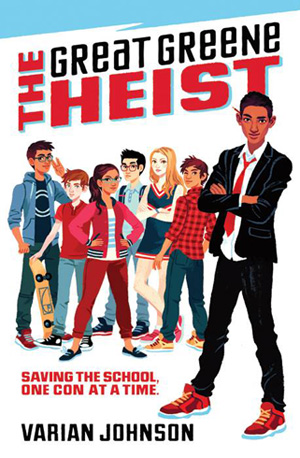 The Great Greene Heist
The Great Greene Heist
By Varian Johnson
Arthur A. Levine Books (an imprint of Scholastic)
$16.99
ISBN: 978-0-545-52552-7
Ages 10 and up
On shelves May 27th
What is the ultimate child fantasy? I’m not talking bubble gum sheets or wizards that tell you you’re “the chosen one”. Let’s think a little more realistically here. When a kid looks at the world, what is almost attainable but just out of their grasp for the moment? Autonomy, my friends. Independence. The ability to make your own rules and to have people fall in line. Often this dream takes the form of numerous orphan novels (it’s a lot easier to be independent if you don’t have any pesky parents swooping about), tales in which the child is some form of royalty (orphaned royalty, nine times out of ten), and other tropes. But for some kids, independence becomes a lot more interesting when it’s couched in their familiar, everyday, mundane world. Take middle school as one such setting. It’s a place a lot of kids know about, and it wouldn’t take much prodding for readers to believe that beneath the surface it’s a raging cesspool of corruption and crime. The joy of a book like The Great Greene Heist is manifold, but what I think I’ll take away from it best is author Varian Johnson’s ability to make this a story about a boy who knows how to do something very well (pulling cons) while also telling a compelling tale of a kid who knows what it means to be in charge and never abuses that power. If the ultimate child fantasy is to be in charge, the logical extension of that is to be the kind of person who is also a good leader. With that in mind, this book is poised to make a whole lotta kids very happy.
Since The Blitz at the Fitz the former con king Jackson Greene has gone straight. Trained in the art of conning by his own grandfather, Jackson’s the kind of guy you’d want on your side when things go down. Yet he seems perfectly content to put that all behind him, just tending the flowers of his garden club like he’s a normal kid or something. Normal, that is, before he gets wind that something shady is going on and it involves the upcoming school election. Gabriela de la Cruz (a.k.a. Gabby), the girl he inadvertently betrayed, is running for Class President against the ruthless Keith Sinclair. Worse? It looks like Sinclair and his dad have the principal in their pocket and that no matter what Gabby does she’ll be facing a defeat. Now it’s time for Greene to come out of retirement and assemble a crack team to use Keith and the principal’s worst instincts to their ultimate advantage. All it’s going to take is the greatest con Maplewood Middle School has ever seen.
To write a good con novel you have to be a writer confident in your own abilities. Johnson exudes that confidence, particularly when he takes risks. Since, at its essence, this is the story about a boy tricking a girl into doing what he wants, it would be easy for Johnson to slip up at any time and make the storyline either condescending or downright offensive. That he manages not to do this is nothing short of a minor miracle of modern writing. Much of this book is also actively engaged in the act of testing the reader’s sympathies. Johnson is misdirecting his readers as often as he is misdirecting his characters and he’s doing it with the given understanding that if they stick with the story they’ll be amply rewarded with more sympathetic motivations later on down the line. To do this in a book for kids is risky. You’re asking your readers to look at your hero as an antihero. And even if they’re sympathetic to his cause, will that translate into them continuing to read the book? In this case . . . yes.
One takeaway I took from this novel was the fact that Johnson really knows his age bracket. More to the point, he knows what kids today are really like. At first I found myself confused when I discovered that The Tech Club and The Gamer Club in this book were two very distinct and different entities. Under the old rules of middle school literature, anything that sniffed of video games or techie concerns would have been filed under “hopeless geekdom”. But in the 21st century we’re all geeks on some level. We’re all hooked up to our phones and computers. Big plot points in this book focus on the bribing of other kids with video games. The lines are blurring and at no point does anyone, even a bully, call another kid a nerd or geek. That isn’t to say that the bullies are nice or anything. It’s just that when it comes to base insults, some terms just don’t always carry the same cache. The nerds may make our toys but that still doesn’t mean a lot of us are going out and befriending them.
There’s been a lot of talk lately about the dearth of kids of color in books for children. Last year I tried to count as many middle grade books starring African-American boys and I topped out at around six or seven (and most of those were written by celebrities). With its truly multicultural cast (name me the last time you read a contemporary book for kids where TWO of the characters were Asian-American and not twins) and black boy hero dead front and center on the cover, we’re looking at a rare beast in the market. Author Varian Johnson also does a dandy job at avoiding certain tropes that librarians and teachers have grown to detest. For example, one way of making it clear what a character’s skin color is (or eye shape) is to compare them to food. I’m sure you’ve read your own fair share of books where the hero had “caramel colored skin” or “almond shaped eyes”. After a while you begin to wonder why the white kids aren’t being described as having “cottage cheese tinted cheeks” or “eyes as round as malted milk balls”. Johnson, for his part, is straightforward. When he wants to make it clear that someone’s black he just says they have “brown skin and black, curly hair”. See? How hard is that?
He also tackles casual racism with great skill and aplomb. At one point Jackson is facing the school’s senior administrative assistant. She says to him “Boys like you are always up to one thing or another.” Jackson’s response? “He hoped she meant something like ‘boys named Jackson’ or ‘boys who are tall,’ but he suspected her generalizations implied something else.” That is incredibly subtle for a middle school book. Some kids won’t pick up on it at all, while others will instantly understand what it is that Johnson is getting at. Because this character is minor (and her assumptions get neatly turned against her later) this storyline is not pursued, but that doesn’t mean it isn’t appreciated. Racism lives on long and strong in the modern world, but few authors for kids think it necessary to point out the fact. They should. It’s important.
Now you would think that since I walked into this knowing it was a kind of junior high Ocean’s 11 I’d have been on the lookout for the twist. All good con films have a twist. Sometimes the twist is good. Sometimes it’s unspeakably lame or capable of stretching your credulity to its limits. I am therefore happy to report that not only does The Great Greene Heist keep you from remembering that twist is coming, when it does come adult readers will be just as flummoxed by it as the kids.
If I were to change one thing about the book, it would be to include something additional. For some readers, keeping characters straight can be difficult. Johnson respects his readers’ instincts and intelligence, so he drops them almost mid-stream into the story. You have to get caught up with Jackson and Gabby’s falling out, and when we start our tale we’re in the aftermath of a once grand friendship. That’s fine, but had a character list been included in the beginning of the book as well, I would have had an easier time distinguishing between each new person we meet. I read this book in an early galley edition, so perhaps this problem will be changed by the time the book reaches publication, but if not then be aware that some readers may need a bit of help parsing the who is who right at the beginning.
You know, we talk a lot about the lack of diversity in our books for kids these days. There’s this two-headed belief that either kids won’t pick up a book with a kid of color on the cover and/or that such books are never fun. And certainly while it may be true that the bulk of multicultural literature for children does delve into serious subjects, there are exceptions to every rule. I look at this book and I think of Pickle by Kimberly Baker. I think of fun books that look amusing and will entice readers. Books that librarians and booksellers will be able to handsell with ease by merely describing the plot. With its fun cover, great premise, and kicky writing complete with twist, this book fulfills the childhood desire for autonomy while also knocking down stereotypes left and right. That it’s like nothing else out there for kids today is a huge problem. Let us hope, then, that it is a sign of more of the same to come.
On shelves May 27th.
Source: Galley sent from publisher for review.
Like This? Then Try:
- Pickle by Kim Baker – Similar, but less a con novel than a pranking novel. Both types of stories require that the kids be in charge and the adults fall in line.
- The Fourth Stall by Chris Rylander – If The Great Greene Heist has an Ocean’s 11 feel then The Fourth Stall is The Godfather. Nothing wrong with that.
- Griff Carver, Hallway Patrol by Jim Krieg – A highly underrated novel and almost completely forgotten thanks to its gawdawful cover. But this joke on the hard-boiled cop genre definitely reminded me of the tone Varian Johnson set with his own book.
- You Killed Wesley Payne by Sean Beaudoin – Perhaps only because it features cliques as distinct entities vying for power, but that’s enough for me. But it’s YA so make note of that as well.
First Sentence: “As Jackson Greene sped past the Maplewood Middle School cafeteria – his trademark red tie skewed slightly to the left, a yellow No. 2 pencil balanced behind his ear, and a small spiral-bound notebook tucked in his right jacket pocket – he found himself dangerously close to sliding back into the warm confines of scheming and pranking.”
Notes on the Cover: Yes. Yes and also thank you. Now granted, the original cover was pretty cool. Seen here:
But at least they kept the same artist. Now it has more of a movie poster feel. Nothing wrong with that. As long as Jackson himself is front and center that is all I care. Good show, Scholastic. Way to knock it out of the park!
Other Blog Reviews:
Professional Reviews:
- A star from Kirkus
- Publishers Weekly
Misc:
- The book has become a bit of a touchstone for diversity discussions as of late. Thanks in large part to Kate Messner independent bookstores are all working to sell it in droves in what they’re calling The Great Greene Heist Challenge. Impressively, author John Green even offered ten signed copies of The Fault in Our Stars to any bookstore in the U.S. that handsells at least 100 copies of The Great Green Heist in its first month of publication. No small potatoes, that. I certainly hope lots and lots of people will be attempting to read and buy this one.
- Read the story behind the story here.
Video: As of this review there is no book trailer for this book. I hereby charge a middle school somewhere in this country to make an Ocean’s 11 style trailer out of it. Make it and I will post it, absolutely. For a guide, I direct you to this Muppet version of that very thing.
Okay. Now do that with this book.
Blog: A Fuse #8 Production (Login to Add to MyJacketFlap)
JacketFlap tags: Scholastic, Best Books, picture books for older readers, Arthur A. Levine, Best Books of 2014, Reviews 2014, 2014 picture books, 2014 reviews, Reviews, picture books, Shaun Tan, Add a tag
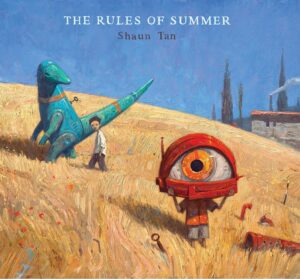 Rules of Summer
Rules of Summer
By Shaun Tan
Arthur A. Levine Books (an imprint of Scholastic)
$18.99
ISBN: 978-0-545-63912-5
Ages 4 and up
On shelves April 29th
When I was a young teen my favorite book was Ray Bradbury’s Dandelion Wine. Steeped in Bradbury’s nostalgia for his youth, I was in the throes of adolescence, probably on some level nostalgic for my own younger days. In this book I reveled in a childhood that was not my own but felt personal just the same. Summer seemed like the perfect time to set such a tale, what with its long days and capacity for equal parts mischief and magic. I loved my summers, even as I failed to know what exactly to do with them. I think of Bradbury’s novel from time to time, though its use for me has long since passed. I found myself going back to it after seeing Shaun Tan’s Rules of Summer. Encompassing a full summer season, Tan indulges his capacity for the odd and extreme while also managing to delve deeply into a relationship between two brothers. The family story is this book’s heart and soul meaning that when all is said and done this is a book for big siblings and little siblings. Miraculously both will see themselves reflected in the pages of the text. And both, if they approach it from the right direction, will find something to pore over in here for years and years to come.
“This is what I learned last summer,” says the book. It’s the kind of statement you might expect to find in an essay on How I Spent My Summer Vacation. Instead, what follows is a series of imaginative, wholly original extremes. Two brothers live in a world of fantastical creatures and gizmos. The younger continually breaks the rules as the elder either berates him or tries to save him from himself. A dinner party of well-dressed birds of prey contains the sentence, “Never eat the last olive at a party” as the older brother pulls his younger away from the potentially deadly entrée. “Never leave the back door open overnight” sees them both facing a living room awash in vegetation and giant lizards, the older boy clearly put out and the younger carrying a bucket and shovel. As the book continues you realize that the younger boy is often at odds with the rules his elder is trying to instill in him. The final straw comes after a massive pummeling, after which the elder brother sells his little bro off to a flock of black birds (“Never lose a fight”). Fortunately, a rescue is made and the book subtly shifts from admonitions to positive statements (“Always know the way home”). The final shot shows the two boys sitting on the couch watching TV, the walls of their living room wallpapered with drawings of the out-of-this-world creatures encountered in the rest of the book.
 As a general rule I try to avoid reading other reviews of the children’s book in my hand until I’ve read the stories myself and gotten a sense of my own perspective. In the same frame of mind I avoid reading the bookflaps of books since they’ve a nasty tendency to give away the plot. Usually I’ll even avoid looking at them after I’ve read the book in question, but there are exceptions to every rule. After reading Rules of Summer I idly turned the book over and read this one on the back cover: “Never break the rules. Especially if you don’t understand them.” Huh. Oddly insightful comment. Aw, heck. I couldn’t resist. I looked at the bookflap and there, lo and behold, the book started to make more sense. According to the flap the rules are those seemingly arbitrary ones that younger siblings have to face when older siblings come up with them. Slowly a book that before had seemed to have only the slightest semblance of a plot began to make a lot more sense. Had I not read the flap, maybe I would have come up with an entirely different interpretation of the pages. Not sure. Whatever the case, I like where the flap took me, even as I suspect that some kids will have entirely different takes.
As a general rule I try to avoid reading other reviews of the children’s book in my hand until I’ve read the stories myself and gotten a sense of my own perspective. In the same frame of mind I avoid reading the bookflaps of books since they’ve a nasty tendency to give away the plot. Usually I’ll even avoid looking at them after I’ve read the book in question, but there are exceptions to every rule. After reading Rules of Summer I idly turned the book over and read this one on the back cover: “Never break the rules. Especially if you don’t understand them.” Huh. Oddly insightful comment. Aw, heck. I couldn’t resist. I looked at the bookflap and there, lo and behold, the book started to make more sense. According to the flap the rules are those seemingly arbitrary ones that younger siblings have to face when older siblings come up with them. Slowly a book that before had seemed to have only the slightest semblance of a plot began to make a lot more sense. Had I not read the flap, maybe I would have come up with an entirely different interpretation of the pages. Not sure. Whatever the case, I like where the flap took me, even as I suspect that some kids will have entirely different takes.
Tan’s strength here lies partly in the fact that these brothers command your equal respect. When I read the book through the first time I thought that the younger brother was the hero. A couple more reads and suddenly the older one started to get more and more sympathetic. Consider, for example, that very first shot of the two after the endpapers. The text reads, “Never leave a red sock on the clothesline.” There, hunched against a fence, the two brothers huddle while a scarlet-hued red-eyed rabbit eyes the sock in question. The older brother has one arm protectively around the younger’s back and his other hand gently cupping his mouth. In later images the younger will mess something up and the older won’t bother to hide his frustrations. The lack of parents in this book is the only way to make it work. When kids deal with one another in the absence of adults, they make their own rules. Even when the elder sells his brother to a flock of birds for a dented crown (his least likable moment) you’re almost immediately back on his side when he rescues his little brother with a pair of bolt cutters a couple pages later. And honestly, what older brother and sister hasn’t fantasized at some point about selling off their annoying little brothers and sisters (see: The great Shel Silverstein poem “Brother for Sale”)? Tan is capable of seeing both sides of the sibling equation. Few picture books even dare.
Tan’s always had a bit of a fascination with the surreal world of middle class life. Suburbia is his Twilight Zone, and he hardly has to add any mechanical monsters or sentient birds to make it unusual. In Tales from Outer Suburbia it was language that primarily painted suburban Australia’s canvass. Here, words are secondary to the art. As I paged through I began to take note of some of the mechanics present on a lot of the pages. Water towers, oilrigs, and even the occasional nuclear power plant. Most beautiful and frightening were the extremely large structures holding the power lines. In one picture the younger brother plays a paddle-based game against a robot opponent while his older brother arbitrates. The sky is an overcast slate gray with these unnerving grids of line and metal towering over them in the background. Extra points if you can find the single black bird that makes an appearance on almost every spread until that climatic moment when it no longer appears.
 Even the endpapers of this book have the power to make you sit and stare for long periods of time. They inspire a feeling that is just impossible to put into words. The endpapers are also the place where Tan makes it clear that he’s going to be playing with light quite a lot in this book. For a fun time, try to figure out where the light source is coming from in each and every one of the book’s pictures. Sometimes it’s evident. Other times, the answer could well be its own little story.
Even the endpapers of this book have the power to make you sit and stare for long periods of time. They inspire a feeling that is just impossible to put into words. The endpapers are also the place where Tan makes it clear that he’s going to be playing with light quite a lot in this book. For a fun time, try to figure out where the light source is coming from in each and every one of the book’s pictures. Sometimes it’s evident. Other times, the answer could well be its own little story.
The thickness to Tan’s paints also marks this as significantly different from some of his other books. Nowhere is this more evident than the cover. Look at the Picasso-like grassy field where the older brother scowls at his younger sibling. The midday sun, the paints so thick you feel like the cover would feel textured if you stroked it, and even the pure blue of the noonday sky has a different Tan tone than you’re used to.
I don’t know if Tan has sons of his own. I don’t particularly care. For all I know the inspiration behind this book came from a relationship with his own brother at an early age. Wherever it might have appeared, one cannot help but feel that Tan knows from whence he illustrates. Thanks to films like Frozen we’re seeing an uptick in interest in stories about siblings of the same gender. Brothers have a tendency to tricky to render on the page (see: the aforementioned Dandelion Wine) but it can be done. Tan has perfectly rendered one such relationship with all its frustrations, betrayals, fights, complaints and deep, enduring love. This book sympathizes with those kids, regardless of their birth order. The rules of childhood are built on shifting sands, causing children everywhere to look longingly at the seeming sanity of adulthood. It’s only when they cross over that these kids will find themselves nostalgic for a time of outsized rules and their overblown importance. Without a doubt, the best book about what summer means to child siblings I’ve ever read.
On shelves April 29th.
Source: Galley acquired at ALA Conference for review.
Like This? Then Try:
- Dandelion Wine by Ray Bradbury
- The Adventures of Beekle: The Unimaginary Friend by Dan Santat
- Journey by Aaron Becker
- The Mysteries of Harris Burdick by Chris Van Allsburg
Other Blog Reviews:
Professional Reviews:
- The Australian
- A star from Kirkus
- A star from Publishers Weekly
Other Reviews: Australian Comics Journal
Interviews: Gillo talks to Shaun Tan about the book here.
Misc:
- The book is available as an app, with music by the hugely talented Sxip Shirey.
- Download the Teacher’s Guide for the book here.
- If you don’t mind knowing as much as Tan himself knows about this book, you can read his commentary about each image here. And yes, he was quite close to his own older brother growing up. So that solves that mystery.
Video:
Seven videos about this book exist on Tan’s website. Check ‘em out if you’ve half a mind to.
And here’s a sneaky peek at the aforementioned app:
And here’s an interview with him about the book on ABC RN:
Blog: The Official SCBWI 10th Annual New York Conference Blog (Login to Add to MyJacketFlap)
JacketFlap tags: Mo Willems, Meg Rosoff, Shaun Tan, Jane Yolen, Margaret Peterson Haddix, mark teague, Floyd Cooper, David Ezra Stein, Arthur A. Levine, autograph party, matthew kirby, #NY13SCBWI, Add a tag
Almost the moment Mo Willems' keynote speech ended, people started lining up to get their books signed and we kid you not, the line ran the length of a football field (that's 100 yards, for those of you unfamiliar with the sport, or 91.44 meters if you're Canadian).
It's no wonder people are so excited to have their books inscribed, when you share the room with the likes of Julie Andrews, Mo Willems, Shaun Tan, Jane Yolen, Tomie dePaolo ...
We could and should go on, but we'll let the pictures speak for themselves.
 |
| Mo Willems |
 |
| Shaun Tan fans standing in a queue (do they say that in Australia?) |
 |
| Shaun Tan |
 |
| Mark Teague and Floyd Cooper |
 |
| Meg Rosoff and David Ezra Stein |
 |
| Lin Oliver and Theo Baker |
 |
| Tomie DePaola and Jane Yolen |
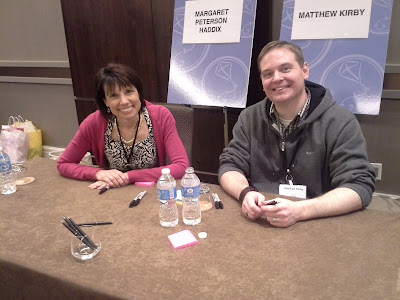 |
| Margaret Peterson Haddix and Matthew Kirby |
 |
| Arthur Levine is a full-service editor. Here, he's opening the book to the right page for an inscription. |
Blog: readergirlz (Login to Add to MyJacketFlap)
JacketFlap tags: Lorie Ann Grover, Little Brown, laini taylor, Arthur A. Levine, daughter of smoke and bone, Erin Saldin, The Girls of No Return, Add a tag

We HEART Laini so much! And wow to her latest novel! Between multiple starred reviews and a movie sale, Daughter of Smoke and Bone is a must to find. You must read it before it hits the big screen. Laini is as fresh are ever. All the divas are talking about this one. Congrats, Laini!
Daughter of Smoke and Bone
by Laini Taylor
Little Brown Books, 2011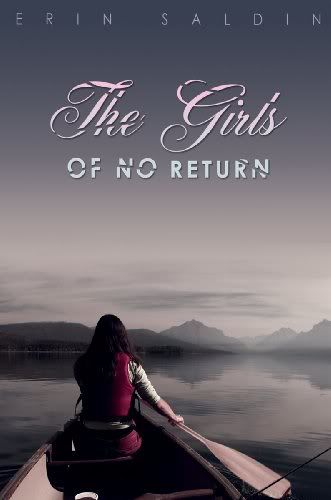
And here's a heads up sneak peek for February, 2012. Watch for The Girls of No Return by Erin Saldin. Kirkus calls the work, "A smashing debut." I was intrigued and held in wonder and suspense from the first page. Be prepared for a journey into the wilderness and into self. Congratulations, Erin! Enjoy the moment!
The Girls of No Return
by Erin Saldin
Aurthur A. Levine Books, February, 2012
Blog: readergirlz (Login to Add to MyJacketFlap)
JacketFlap tags: Sara Easterly, readertotz, Scholastic Press, Arthur A. Levine, Monday is One Day, bedtime kiss for little fish, Hug Hug, Add a tag
A definite perk to the business is getting to hang out with editors and authors made of awesome. Last night I attended Plot for Tots orchestrated by former rgz team member, Sara Easterly. Imagine a toddler mosh pit, an amazing musician, and authors reading board and picture books with proceeds going to charity Page Ahead. Sweet!
What an honor to be included in the awesome lineup along with one of the industry's most charming editor/authors, Arthur A. Levine. Are those not the cutest glasses he wears?
While I read Hug Hug! and Bedtime Kiss for Little Fish, he read Monday is One Day. Watch for my review of his picture book on Friday at readertotz!
Do I need say, here is the U.S. editor for the Harry Potter series? *squeeeeeee* Ah, good times!
 Add a Comment
Add a Comment
Blog: A Fuse #8 Production (Login to Add to MyJacketFlap)
JacketFlap tags: Video Sunday, Philip Nel, silent films, Harry Potter, Neil Gaiman, Uncategorized, book trailers, The Graveyard Book, Make Way for Ducklings, Arthur A. Levine, Julia Mickenberg, Add a tag
First off, today I’d be amiss if I did not direct you to submit your favorite book trailers to the SLJ Trailee Awards.* If you’ve a favorite trailer that was posted between the dates of July 1, 2010 and June 30, 2011, SLJ wants to hear about it. Think back through all the book trailers you’ve seen. What stood out? Pay attention to those dates too. I wanted to vote for the stop motion trailer for Linger but saw it was posted May not July 2010. D’oh!
Now this wasn’t created for the 90-Second Newbery but the creators should submit it anyway. It’s a silent film version of The Graveyard Book by Neil Gaiman and it’s a delight to watch.
I particularly like the “dog”.
And now you guys have some serious luck. Phil Nel and Julia Mickenberg (editors of Tales for Little Rebels: A Collection of Radical Children’s Literature) recently spoke at the Children’s Literature Association’s annual conference held at Hollins University. The topic? Radical Children’s Literature Now! And best of all, the whole talk is online for your viewing pleasure. How awesome is that?
Phil even provided the Bibliography of the talk on his blog. What a fella!
Next up, Potted Potter. It’s an abbreviated take on all seven Harry Potter books ala The Reduced Shakespeare Company. I call it a hoot, but then I forgive a lot when it’s done with a British accent.
Thanks to bookshelves of doom for the link.
Actually Leila found another Potter related link of relative amusement. This works because of the Ghostbusters shirt. I love that such shirts are considered ironic hipsterwear these days.
Some of you have just tasted the delights of the annual SCBWI Conference in L.A. To you I say, lucky ducks. I’ll live vicariously through your blog updates and Twitter
Blog: A Fuse #8 Production (Login to Add to MyJacketFlap)
JacketFlap tags: Uncategorized, middle grade fiction, fantasy, middle grade fantasy, Scholastic, Sally Nicholls, Arthur A. Levine, 2011 reviews, 2011 middle grade fiction, British imports, Add a tag
 Season of Secrets
Season of Secrets
By Sally Nicholls
Arthur A. Levine (an imprint of Scholastic)
$16.99
ISBN: 978-0-545-21825-2
Ages 9-12
On shelves now
Sally Nicholls is not a household name here in America. She is possibly not even a name that most children’s librarians, booksellers, and teachers would recognize right off the bat. This, in spite of the fact that her previous book Ways To Live Forever was a stunning success. Folks became quite fond of that story about a boy with a terminal disease, and I suppose they expected Ms. Nicholls to do more of the same. That’s the trouble with starting off your career with realism. Move into fantasy and you’ll find that the fantasy fans don’t really know who you are and the realism fans are disgusted that you haven’t produced more of the same. Separate Season of Secrets from its predecessor, however, and what you have is a hearty little novel about a girl learning about the cruel war between the seasons, in the midst of her family’s own personal tribulations.
Since Molly and Hannah’s mother died they’ve been handling it as best they could. Their father, however, has not been handling it well. Not a jot. So distraught is he by the loss of his wife, in fact, that he sends his two daughters off to live with their grandparents in the country. One night Molly is witness to a frightening vision of a man run down by a pack of dogs and a horned man on a horse. In the ensuing days she tries to tell others, to no avail, then discovers the man in a nearby shed. She cannot nurse or help him, but she can learn as much as she can about him and what exactly he is. As she does, her father is drawn more and more into her life with her sister, though it takes him many tries and many mistakes before any progress can be made. The return of her father and the eventual destruction of the man come together in such a way as to give rise to winter, and the ensuing, beautiful, spring.
I’ve been reading so many books lately that don’t give a fig for beautiful language. Coming across Ms. Nicholls felt like a gulp of cool water then. I wasn’t two pages in when Molly let loose with the descriptive, “Hannah is one and half years older than me, yet she takes up about one and a half million times more space.” And later, “My dad’s shirts are always stiff and clean and white; you button him up all the way to his throat and there he is, locked up safe and going nowhere.” I love a book that gives everyday descriptions real personality and flair. It’s the signature style of Ms. Nicholls. It’s something you can count on in every book she writes.
And then there was an element to this title that I found simultaneously clever and frustrating. Age. Here we have a tale of two sisters, one older, one younger, and there’s not a moment in this story when we’ve a clear sense of how old they are. This is frustrating to a reviewer like myself since you judge how believable you find a character based, in large part, on whether or not they accurately act their age. I would have thought that Molly was acting a bit young for her age at quite a few points in the story, except that for all I know Molly could be seven or she could be ten. My suspicion is that Ms. Nicholls gave Molly a younger age, but then realized something. If you write a middle grade novel for 9-12 year-olds and you make yo
Blog: The Official SCBWI 10th Annual New York Conference Blog (Login to Add to MyJacketFlap)
JacketFlap tags: SCBWI Master Class, Arthur A. Levine, Add a tag
The big finale.
Another dramtic start: Arthur has apprently had too much coffee and diet Coke. We still don't know if the missing assignments have been recovered. Perhaps it will all come to an exciting conclusion.
Last night's assignment was to take the same snapshots we used for our first piece of writing, and now use them to create a new piece with a different emotion than was conveyed the first time.
More good, concrete ideas from Arthur as we share our writing:
- It's important to know who the scene is important to;
- Watch for stock phrases like, squeal of delight and an exhausted sigh. What does it really sound like?
- When the words are generic, it can make the reader lose interest. When words are specific, it will make the reader sit up and take notice;
- Make sure the words you choose are the ones your character would use;
- When you get nostalgic you must push back to that time to make the writing stronger;
- The emotion informs how you're telling the story.
(As for the exciting conclusion of The Case of the Missing Homework, it was found in the Lost and Found.)
Blog: The Official SCBWI 10th Annual New York Conference Blog (Login to Add to MyJacketFlap)
JacketFlap tags: SCBWI Master Class, Arthur A. Levine, Add a tag
 Class began on a dramatic note: The box for completed assignments was somehow emptied out and put to use in the joke contest. (Oh, the cruel irony. The joke box, people! The joke box!) If anyone knows where these assignments went, please hand them to an SCBWI staffer.
Class began on a dramatic note: The box for completed assignments was somehow emptied out and put to use in the joke contest. (Oh, the cruel irony. The joke box, people! The joke box!) If anyone knows where these assignments went, please hand them to an SCBWI staffer.
We are discussing our written assignments--turning our sensory snapshots into 350-word pieces that convey a particular emotion. Each writer is reading his or her work aloud, and Arthur is identifying the emotion the language and imagery convey.
He's giving us good, concrete advice:
- Give us images that cut past sentiment (fresh, vivid ones);
- Keep the tone consistent;
- Make sure the language you choose supports the emotional target you're aiming for; and
- Observe things precisely to identify exactly the words you want to use.
Blog: The Official SCBWI 10th Annual New York Conference Blog (Login to Add to MyJacketFlap)
JacketFlap tags: GLBTQ, Arthur A. Levine, Tony Valenzuela, Lee Wind, Aaron Hartzler, LA10, Add a tag
There's been a new addition to the panel for this morning's breakout workshop "A Look At The LGBTQ Marketplace" with Aaron Hartzler (Director of Communications, SCBWI), Arthur A. Levine (Vice President of Scholastic and publisher of his own imprint, Arthur A. Levine Books - as well as an author himself), and Tony Valenzuela (Executive Director of the Lambda Literary Foundation):
ME, Lee Wind (Writer and Blogger of "I'm Here. I'm Queer. What the Hell do I Read?" where over 200,000 visitors have come to find out about GLBTQ Teen books, culture and politics!
I hope you can join us in the Palisades Room, 11:15am - because this is going to be awesome!
Blog: The Official SCBWI 10th Annual New York Conference Blog (Login to Add to MyJacketFlap)
JacketFlap tags: GLBTQ, Lee Wind, Arthur A. Levine, LA10, Tony Valenzuela, Add a tag
More than 40 of us took over the north row of gazebos by the pool at Friday's lunchtime to mingle and meet and talk Gay, Lesbian, Bisexual, Transgender, Questioning and Allied Characters and Themes in Children's and Teen literature. We were joined by Arthur A. Levine and Tony Valenzuela, who were gracious and candid in their answers and comments.
We went around the circle and everyone introduced themselves to the group, sharing what they were working on and mentioning what (if any) GLBTQ content was included in their work.
A few illustrators wondered what opportunities existed for children's book illustrators to include queer content, and we spoke about Marla Frazee's "Everywhere Babies" and a new picture book Arthur A. Levine has coming out (as an author) "Best Best Colors" as examples of the power illustrators have to show diversity in their art and in the books children experience.
Arthur fielded questions on how to include a gay character in a way that wasn't stereotypical (make sure the character is a fully realized character - i.e., if they're muscular - why? how did they get that way?) and about the challenge of including queer content (and diverse content in general) in middle grade books where it's not the main character's focus.
Tony shared that this past year, there were more Childrens/YA submissions than 21 other categories (second most out of 23) for the Lambda Literary Award.
And I brought up, from my perspective blogging at "I'm Here. I'm Queer. What the Hell do I Read?" that the tide is shifting - we're no longer in a world with only one or two books representing Queer characters - and with more representations, the pressure to make any one GLBTQ character representative, or perfect, lessens. (And who wants to read about perfect characters anyway?)
All in all, everyone's appetites were whetted for tomorrow's 11:15AM Workshop, when we'll be able to dive in even deeper!
A Look At The LGBTQ Marketplace - Palisades room
With Aaron Hartzler,
Arthur A. Levine
Tony Valenzuela
and
yours truly, Lee Wind.
Hope to see you there!
Blog: The Official SCBWI 10th Annual New York Conference Blog (Login to Add to MyJacketFlap)
JacketFlap tags: craft, SCBWI Master Class, Arthur A. Levine, unstoppable disco fever, Add a tag
 Arthur A. Levine is a Vice President at Scholastic Inc. and the Publisher of Arthur A. Levine Books. He is also an author and has a picture book coming out coming out next spring (MONDAY IS ONE DAY). What's more, you can follow his new blog here.
Arthur A. Levine is a Vice President at Scholastic Inc. and the Publisher of Arthur A. Levine Books. He is also an author and has a picture book coming out coming out next spring (MONDAY IS ONE DAY). What's more, you can follow his new blog here.
Oh, Arthur! Is there anything you can't do? (Don't be jealous, friends, but Arthur did sing a little David Cassidy for us. He has perfect pitch and a very nice sort of disco-ish "hallelujah" move, which is why I snagged the classic photo of Arthur with his David Cassidy hairdo. See below.)
Anyhoo.
The class is focusing on how writers can put emotions on the page. Our blog posts and tweets over the next few days will recap class highlights, and will offer up some of the assignments so you can follow along. The David Cassidy soundtrack is recommended, but ultimately optional.
Our first assignment: to think of a place to which we have a strong emotional attachment. It doesn't matter if it's a positive or negative attachment. Now, with this place in mind, write down five snapshots. Images full of sensual detail. Visualize the place. Hear the sounds. Smell the smells.
Good. Now we're on Step 2. Each of us reads three favorite snapshots. After this, we write down the three we most remember from the eighty-one read aloud. (What, you think we writers can't do math? Zing!)
For Step 3, we talked a bit about why the memorable ones stuck with us:
- they had emotional associations from childhood;
- they were vivid;
- they carried emotional weight (in one example, parents' faces were described as bearing bad news);
- they were direct;
- they contained memorable words;
- they conveyed emotional complexity; and
- they were sensory images.
Blog: A Fuse #8 Production (Login to Add to MyJacketFlap)
JacketFlap tags: Alvina Ling, Uncategorized, Laini Taylor, Karla Kuskin, Arthur A. Levine, Cynthia von Buhler, Fusenews, Claire Huchet Bishop, Fairuza Balk, Marcia Brown, Natasha Fadeeva, Patton Oswalt, snore-filled tears, The Seven Chinese Brothers, Tunde Adebimpe, Add a tag
 Things that I have difficulty understanding: The rules of soccer. How to work an f-stop on a camera (or what it even means). The French language. The fact that actors Patton Oswalt and Tunde Adebimpe appear to be in a movie that is filming right now and is going by the title . . . The Seven Chinese Brothers. That brings to mind the Margaret Mahy version, not to mention the controversial Claire Huchet Bishop one (though that story had only five brothers in it). Actually, Ms. Bishop used to work in my children’s room (though when folks ask we usually mention the fact that Marcia Brown worked here first). The internet is curiously mum about this Patton/Adebimpe project so . . . we’ll just assume that it’s another picture book to screen adaptation. It gives my existence just the right dose of insanity I crave on a daily basis.
Things that I have difficulty understanding: The rules of soccer. How to work an f-stop on a camera (or what it even means). The French language. The fact that actors Patton Oswalt and Tunde Adebimpe appear to be in a movie that is filming right now and is going by the title . . . The Seven Chinese Brothers. That brings to mind the Margaret Mahy version, not to mention the controversial Claire Huchet Bishop one (though that story had only five brothers in it). Actually, Ms. Bishop used to work in my children’s room (though when folks ask we usually mention the fact that Marcia Brown worked here first). The internet is curiously mum about this Patton/Adebimpe project so . . . we’ll just assume that it’s another picture book to screen adaptation. It gives my existence just the right dose of insanity I crave on a daily basis.
- By the way, if you’re still a little fuzzy on who that Patton Oswalt fellow is, (A) He was the voice of Ratatouille and (B) I just stumbled on his commencement speech given when he returned to his high school and it is precisely what I needed to read right now.
- New Blog Alert: Hardly counts if they’re famous, right? Aw, heck. Even famous editors need their plugs! Ladies and gentlemen, it is my distinct pleasure to inform you that the great Arthur A. Levine, editor of the very Harry Potter books themselves and the man who helped to add the term Muggle to the American lexicon, is blogging. Granted, he has only a single solitary post up at the moment, but I anticipate great things for young Mr. Levine. Not that he doesn’t have a tough act to follow. His right hand, Cheryl Klein, has been mastering the form for years (there’s a new The Year of Secret Assignments cover?!!!)
- Hey! When I reviewed The Strange Case of Origami Yoda the other day I had no idea that it owed its birth to a BoingBoing piece. BoingBoing apparently just got alerted to that fact too. They seem grateful (though a BoingBoing review wouldn’t be out of place as well).
- I love it when a plan comes together. Or, to be more precise, I love it when folks I like decide to make books together. Folks that I like include author Laini Taylor and editor Alvina Ling. I have liked Laini’s work ever since I read her fantastic The Faeries of Dreamdark: Blackbringer (now known merely as Blackbringer). I have liked Alvina’s work ever since I read The Year of the Dog by Grace Lin. I have liked the two of them from
7 Comments on Fusenews: King Friday the XIII gave the rehearsal dinner speech, last added: 6/24/2010Display Comments Add a Comment
Blog: The Official SCBWI 10th Annual New York Conference Blog (Login to Add to MyJacketFlap)
JacketFlap tags: Paula Yoo, Etiquette, Lee Wind, Arthur A. Levine, NY10, Add a tag
And here, as a public service announcement, we share with you the inestimable Arthur A. Levine, Vice President of Scholastic Inc. and the Editorial Director of Arthur A. Levine Books, taking a momentary break after a full day at a SCBWI conference:
Behind the camera "evil" mastermind... Lee Wind
--Posted by Lee Wind
View Next 1 Posts




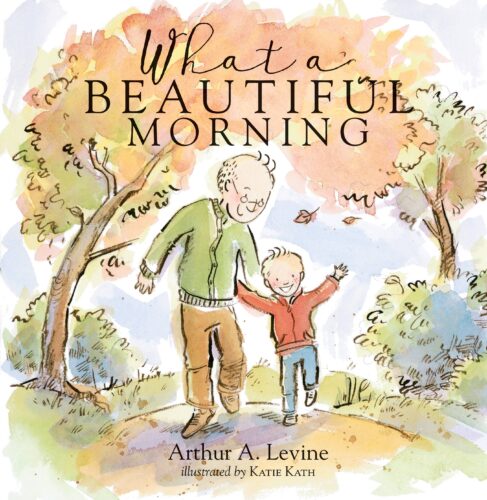
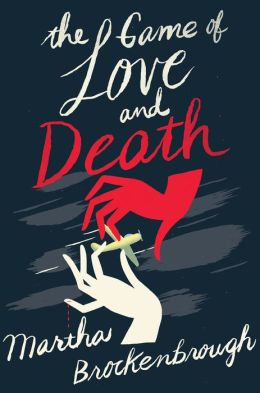

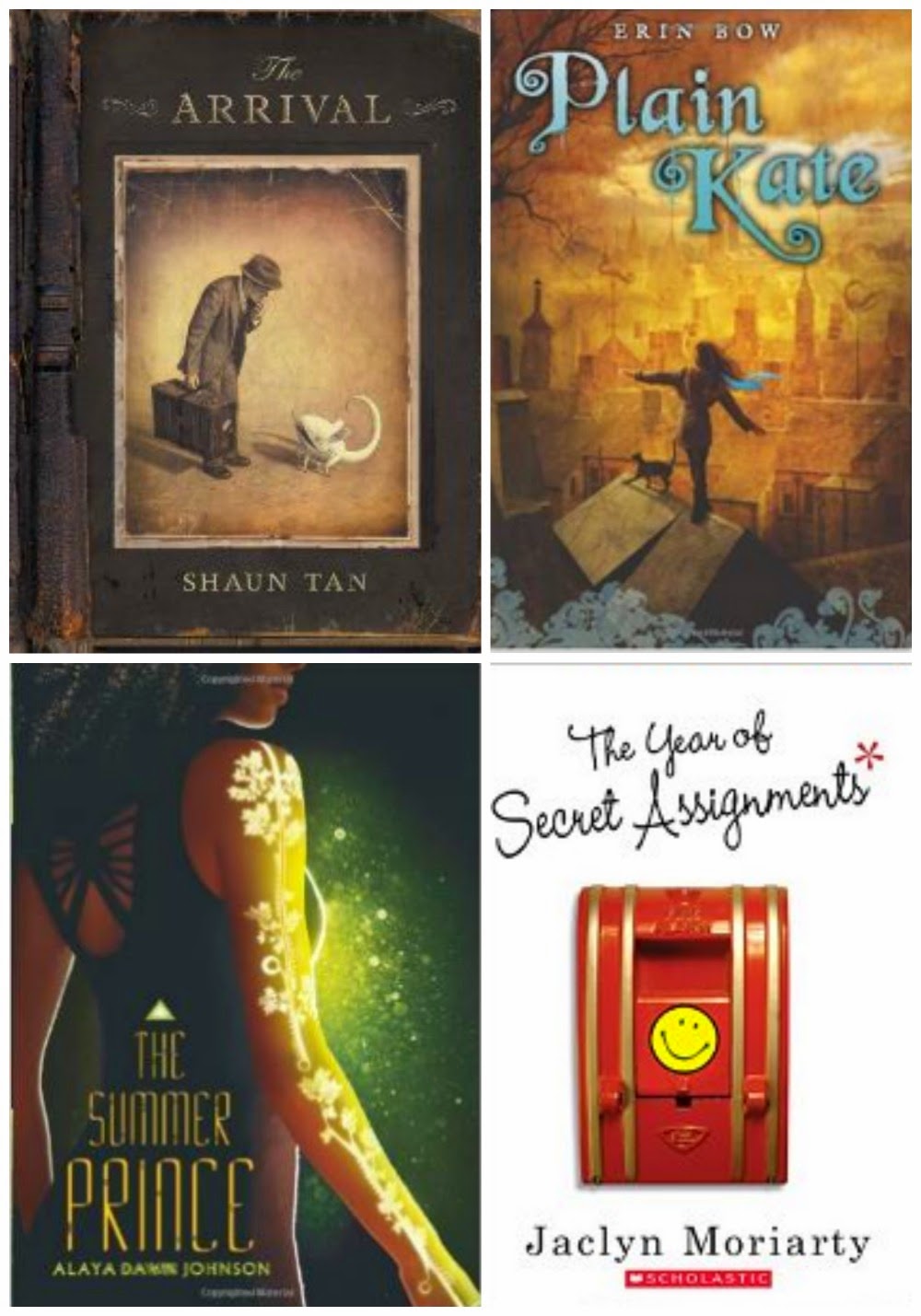


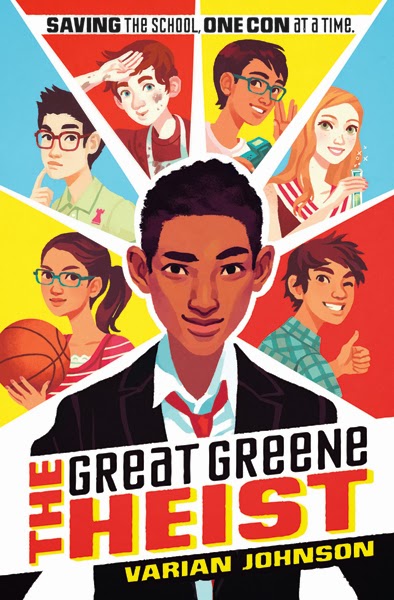




WHAT A BEAUTIFUL MORNING lives up to its title – it’s a beautiful, funny, profoundly moving book. I was in the room (THE ROOM WHERE IT HAPPENED, #Hamilton) at an event last year when Arthur did a reading, and everyone in the room was floored. Don’t miss this one.
I was in the room where it happened, too, and I’m really excited that WHAT A BEAUTIFUL MORNING is one step closer to getting out in the world.
I was NOT in the room when it happened.
But Arthur edited a picture book of mine years ago
AND Katie Kath has illustrated my new picture book, coming March 15th.
(Can you hear the Twilight Zone music?…)
I guess the rest of us will just have to wait for it, wait for it…
I remember, Mike. I was deeply moved. I cannot wait to hold this in my hands.
I’m about to become a granny for the first time, and the cover alone turns me to mush.